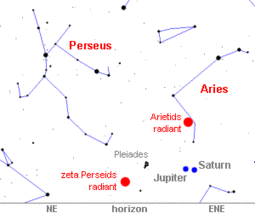Zeta Perseids
From Wikipedia, the free encyclopedia
| Zeta Perseids | |
|---|---|
 Appearance of the eastern sky at 5:00 am on June 7, 2000 from a mid-northern latitude observing site. | |
| Discovery date | 1947[1] |
| Parent body | 2P/Encke (Taurid Complex) |
| Radiant | |
| Constellation | Perseus |
| Properties | |
| Occurs during | May 20 – July 5[1] |
| Date of peak | June 9[2]–13[1] |
| Velocity | 29[3] km/s |
| Zenithal hourly rate | 40 (radar)[1] |
| See also: List of meteor showers | |
The Zeta Perseids (ζ–Perseids) are a daylight meteor shower that takes place from about May 20th to July 5th.[1] The shower was discovered at Jodrell Bank Observatory in 1947 using radio equipment.[1] The Zeta Perseids and Beta Taurids are both probably associated with the Taurid Complex of meteor showers.[2] The Arietids and Zeta Perseids maxima tend to blend into one another.[2]
References
- ↑ 1.0 1.1 1.2 1.3 1.4 1.5 Gary W. Kronk. "Observing the Zeta Perseids (ζ–Perseids)". Meteor Showers Online. Retrieved 2011-10-12.
- ↑ 2.0 2.1 2.2 "IMO Meteor Shower Calendar 2012: April to June". International Meteor Organization (IMO). Retrieved 2012-11-26.
- ↑ "June's Invisible Meteors". NASA News. 2000-06-06. Retrieved 2012-11-26.
| |||||||||||||||||
This article is issued from Wikipedia. The text is available under the Creative Commons Attribution/Share Alike; additional terms may apply for the media files.